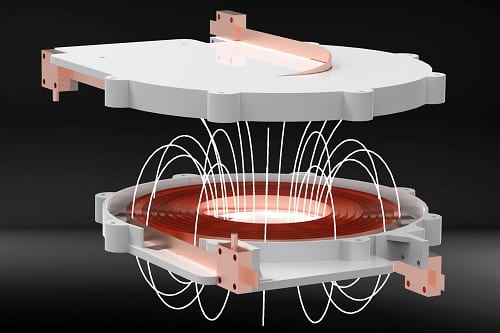The innovation has the capability of transmitting contactless power in several kilowatts without producing major losses

Contactless power transmission has already established itself as a key technology for charging small devices such as smartphones and electric toothbrushes. Users would also like to see contactless charging made available for larger electric machines such as industrial robots, medical equipment and electric vehicles.
With this in mind, a team of physicists at the Technical University of Munich (TUM) has succeeded in making a coil that has superconducting wires capable of contactless power transmission in the order of more than five kilowatts and produces only small losses. The wide range of conceivable applications includes autonomous industrial robots, medical equipment, vehicles and even aircraft.
Before developing this impressive innovation, researchers had to overcome the challenge of reducing the alternating current losses that occur in superconducting transmission coils. These losses are known to increase as transmission performance rises, leading to surface temperature increase of the superconducting wires rises and eventual superconduction collapse.
To mitigate this, the researchers developed a special coil design in which the individual coil windings are separated from one another by spacers. “This trick significantly reduces alternating current loss in the coil,” says Christoph Utschick, PhD student at the Technical University of Munich (TUM). “As a result, power transmission as high as the kilowatt range is possible.”
Optimised prototyping
For their prototype, the team chose a coil diameter that resulted in a higher power density than is possible in commercially available systems. “The basic idea with superconducting coils is to achieve the lowest possible alternating current resistance within the smallest possible winding space and thus to compensate for the reduced geometric coupling,” says Utschick.
This called on the researchers to resolve a fundamental conflict. If the distance between the coil windings became small, the coil would become very compact and the danger of superconduction collapse during operation will arise. On the other hand, larger separations would result in lower power density.
“We optimised the distance between the individual windings using analytical and numerical simulations,” says Utschick. “The separation is approximately equal to half the width of the tape conductor.”
Overcoming further challenges
The researchers now want to work on further increasing the amount of transmittable power. If they succeed, the innovation will open the door to a large number of very interesting application areas, such as industrial robotics, autonomous transport vehicles and high-tech medical equipment. Perhaps, it will be possible to charge electric racing vehicles while being on the race track, as well as autonomous electric aircraft.
Wide-scale applicability of the system still faces an obstacle, however. The coils require constant cooling with liquid nitrogen and the cooling vessels used cannot be made of metal, otherwise, the metal vessel walls would considerably heat up in the magnetic field, much as a pot does on an induction stove.
“There is as yet no cryostat like this which is commercially available. This will mean an extensive amount of further development effort,” says Rudolf Gross, Professor for Technical Physics at the Technical University of Munich and Director of the Walther-Meissner-Institute of the Bavarian Academy of Sciences and Humanities. “But the achievements up to now represent major progress for contactless power transmission at high power levels.”
The project was undertaken in a research partnership with companies like Würth Elektronik eiSos and Theva Dünnschichttechnik.






